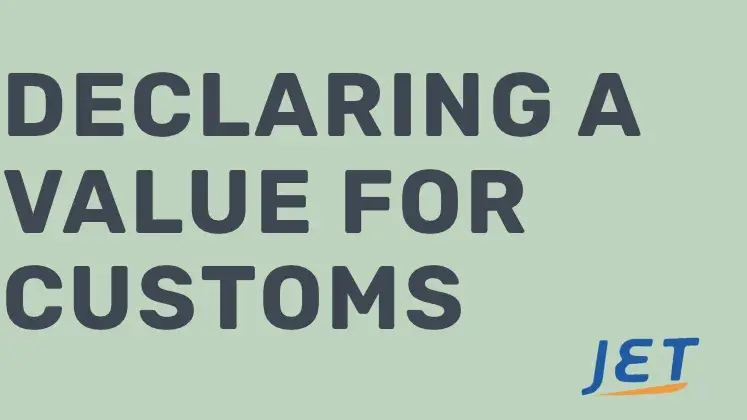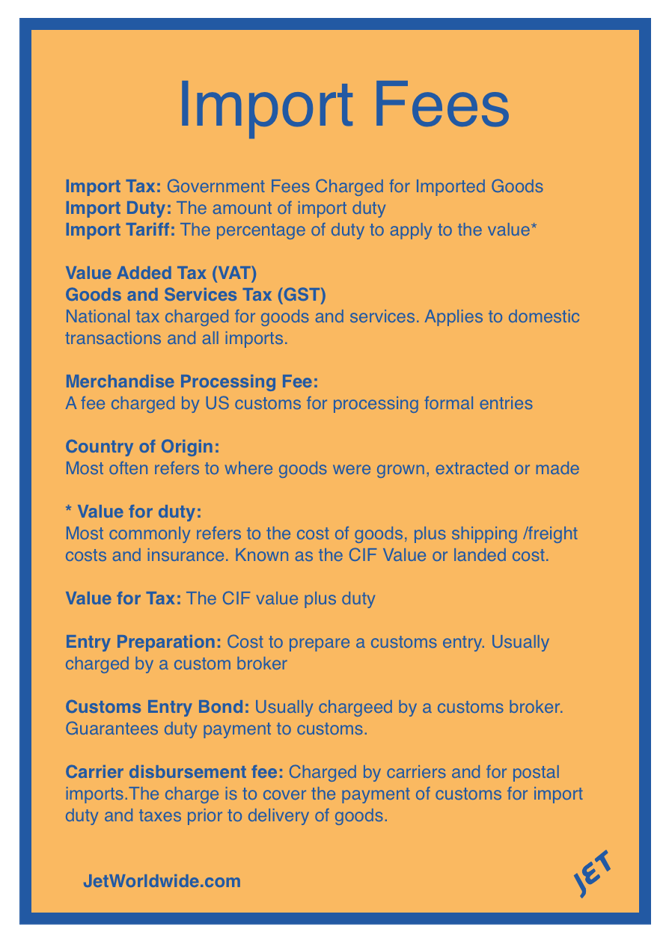
Do not Undervalue the importance of declared value
Value plays a pivotal role in international customs. It forms one of the cornerstone of import and export processes. The correct determination of the value for customs is essential. The value of goods is the basis for the calculation of customs duties, taxes, and fees. Additionally, value is an important data point used by governments. Trade policies, tariff rates, and trade agreements rely on a standardized valuation process.
 Contact our team for an initial consultation.
Contact our team for an initial consultation.
The Purpose of Customs Valuation is to determine the value of goods for customs purposes.
It is important to have a standard set of rules for establishing the total customs value of goods for many reasons. To determine how much import duty the package recipient must pay against the shipment, it helps to start with the basics. Customs authorities need to have a clear understanding of value. Import duty and tax is most often calculated as a percentage of the value of goods.
What is the difference between declared value and value for Customs?
The several terms used with respect to value. Terms related to value can seem similar but actually have a very different meaning.
Customs Value:
The value assigned to goods transporting cross border.
Declared value:
Declared value and customs value are interchangeable. However, “declared value” is also a carrier term related to the value for insurance. See section below on declared versus insured value.
Transaction Value:
The transaction value is the price actually paid -or payable- for the goods.

CIF Value:
The CIF (cost + insurance + freight) value is the cost of the goods plus the cost for shipping and insurance.

Value for Duty:
The value for duty (VFD) is the value adjusted in accordance with local customs and World Trade Organization's (WTO) rules. Often the value for duty is the CIF value discussed above.
Review international resources for customs valuation (PDF)
US customs does not consider CIF value
US Customs considers only the cost of the goods as the value for duty. The costs of goods can include other items, such as:
- The packing costs incurred by the buyer
- Any selling commission incurred by the buyer
- The value, apportioned as appropriate, of any assist
- Any royalty or license fees as a condition of the sale
- The proceeds of any subsequent resale, disposal, or use that accrue to the seller
What is Intrinsic value?
The definition of “intrinsic value” refers to the price of the goods themselves when sold for export. It excludes transport and insurance costs, unless they are inclusive in the price. If price includes shipping and insurance it must be separately indicated on the invoice. For goods of a non-commercial nature, the price which for payment for the goods themselves.
Consignment versus Goods
The the term “consignment” refers that ship together from a single consignor to a single consignee. A consignment is covered by the same transport waybill and tracking number.
Declared value as insurance value
As mentioned above, declared value is what most casually refer to as insurance. However, carriers (including UPS and FedEx) explicitly state they do not provide insurance. Even if most understand declared value as a type of insurance, it is not such. Some shippers fill in the “declared value” field thinking it is the customs value. And then unknowingly charged for this “insurance type” of charge. Although not insurance per se, declared value raises the financial liability of the carrier. Depending on the shipping company that you use, the declared value will represent different things.
This particular value for common carriers determines the maximum amount you can claim when for a lost or shipment with damage in transit.
 Note: Insurance against damage in transit is subject to difficult approval processes. Shipper must document inner and outer proper packaging. Notation of damage is mandatory upon delivery.
Note: Insurance against damage in transit is subject to difficult approval processes. Shipper must document inner and outer proper packaging. Notation of damage is mandatory upon delivery.
FedEx and UPS typically set this value at around $100 unless “declared” at a higher amount. These and other carriers state that this is not an insurance liability for the shipment. Yes, a bit confusing. We recommend third part insurance for high value shipments.
Learn more about First Sale method of value for USA imports
Value for duty calculation
Duty calculation uses following three elements: Value, HS classification, Country of Origin.
Value for customs
- What the sender defines as the shipment value is the declared value of the shipment. Customs can change or correct the value.
- An over valued shipment will result in higher import costs.
- An undervalued shipment will result in a false customs declaration. It is important to get this right.
- The receiver of the goods is usually the importer of record. The importer is responsible for assigning the correct value to the shipment.
Value per unit versus total value per shipment
The value declaration is best defined as the value of each unit. Customs entries commonly require the value per unit. The unit value times the number of units equals the total value. Read more: Confirm the correct declared value for your shipment.
Risk of Undervaluing Shipments
While it is important to declare this value correctly, data shows that many systematically undervalue shipments. Customs is globally becoming more focused on correct valuation. Yet the problem still persists. Undervalued shipments are subject to delays, confiscation and customs fines. Be prepared to provide proof of purchase when exporting and importing a consignment.
What value should to declare when there is no commercial transaction?
There are times when the goods shipped have no commercial sale. When there is not an actual transaction value. This can happen in the case of sending product samples or warranty parts. This can be a bit tricky. The first thing to do is to be sure to mention on the invoice for customs is that there is no commercial value. Phrases like “commercial samples” and “not for resale” can be helpful.
In such cases, the value can be the cost price or value of similar goods. Another method is to use the retail price (in the case of a gift). Some customs authorities require a copy of the retail receipt.
What about valuation for inter-company shipments?
There are also transactions within companies, where one business unit delivers goods to another business unit. When goods transfer within companies, the inter-company calculation may differ from the customs value.
Calculating import duties using these prices would mean the Customs Authority would receive less than required. This is why there is always an additional focus on inter-company deliveries. It is of the utmost importance to use a diligent process to determine the customs value.
Important information regarding valuation for non-resident imports to Canada.
Understanding the Declared Value of FedEx and UPS
Many view the declared value of FedEx and UPS as the insured value of the shipment. Yet, as mentioned above - It is not insurance coverage per se. If no declare value, the maximum liability is $100. The value declaration should sufficient in case of package loss or damage. We generally recommend to get third party insurance as carriers rarely pay claims - which is why it is so profitable for the carriers. Read more about insurance.
To get third party insurance, you must obtain it from insurance brokers and others (such as Jet Worldwide). Read more about insurance for shipping.
Shipping insurance is a crucial aspect of any shipping process. And, for insurance the key is packaging, documentation and packaging (yes, packaging is that important!).
If you want to save on shipping, it is crucial to understand the distinction between declared value and shipping insurance. Now that we've already discussed the former, let's delve into the latter. The monetary coverage you get for your shipment to protect it against loss or damage is shipping insurance.
Use of third-party insurance providers, such as Jet Worldwide. Jet provides coverage for valuable shipments if you booked a shipment via Jetship. We send a draft proposal of the insurance coverage for your review prior to shipping.
Value and Global Duty Free Thresholds
Although there are notable exceptions, the basic rule for sending e-commerce shipments to the USA, Canada, UK and Europe relate to value:
- To the USA: Under US $800: No duty and easier manifest submission
- To Canada: Under CA$20 or $40 (depending upon origin and method of shipping)
- To European Union: Under €135
- To the United Kingdom: Under £150
The European Union and United Kingdom in particular have implemented enforcement measures to reduce the undervaluing of goods.
E-commerce: Duty Free ≠ Tax Free
To the European Union and the UK, most e-commerce goods (see above low value thresholds) can clear duty free. However, VAT of around 20% applies to all goods. This includes goods imported duty free. See our posts on VAT payment for e-commerce to the UK and payment of VAT to the European Union.
It is rare that an e-commerce parcel has a delay at customs due to a mis-declared value.
Valuations: The issue how to value an item can be complex (see our blog on valuations for import). The most common method is the transaction value. In other words, simply declare what the item sold for (including the shipping cost).
Higher low value threshold in the USA. The issue of under-declaring shipments is less important to the USA. American has a high duty free threshold is $800.
Having compliant processes remains the key to long term success! There can be a competitive benefit of under declaring the actual value. We continue to strongly advise cross border e-commerce companies to build legitimate high volume parcel import processes that adhere to regulatory guidelines.
Valuation for e-commerce: Transaction is key
There are a series of valuations methods (see link below a link to our post on valuation). The most common method is the "transaction value." For e-commerce sellers, it is simply what the item sold for. It can get complicated when there is no direct sale such as warranty parts, product samples, returned goods, or used goods return for repair.








